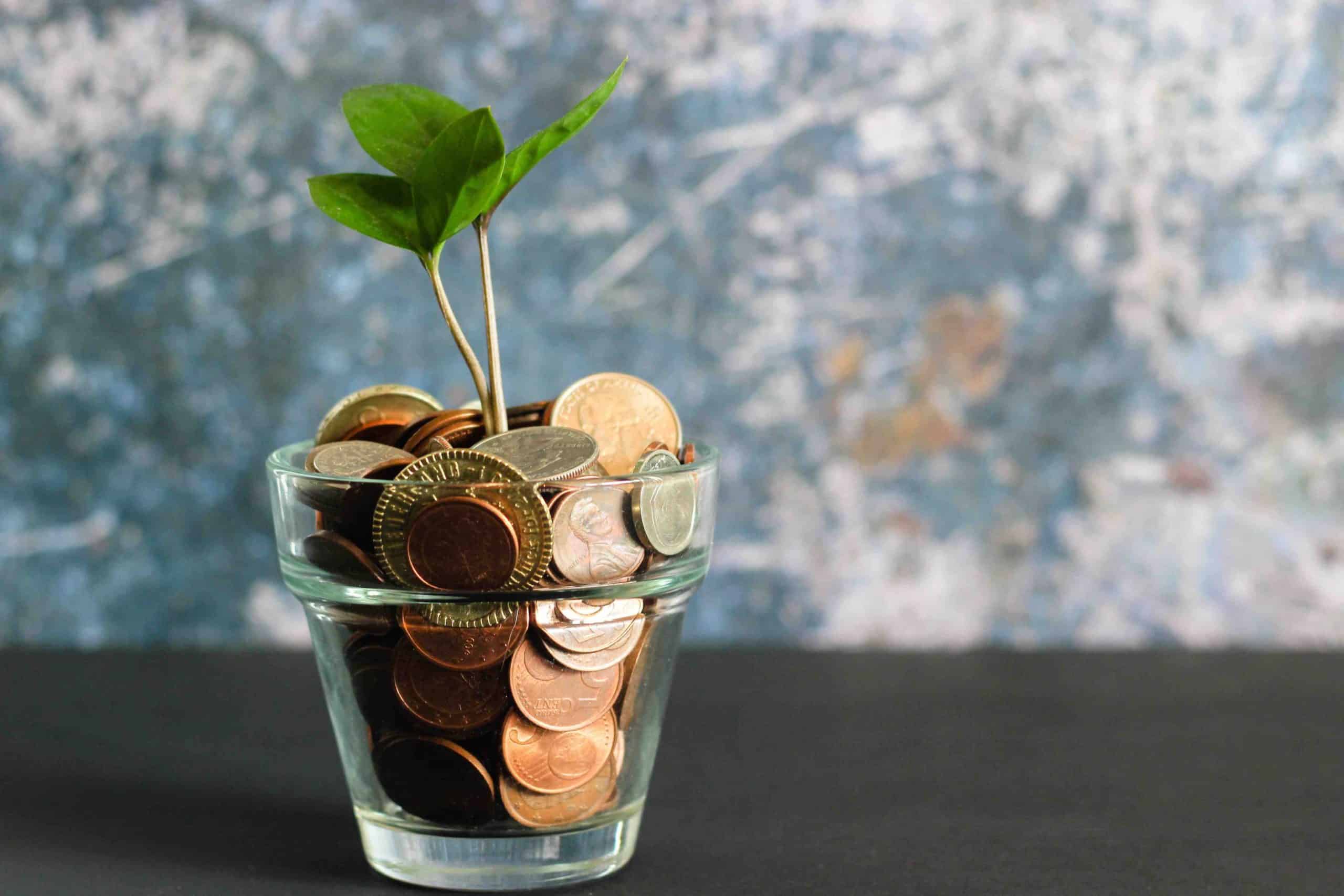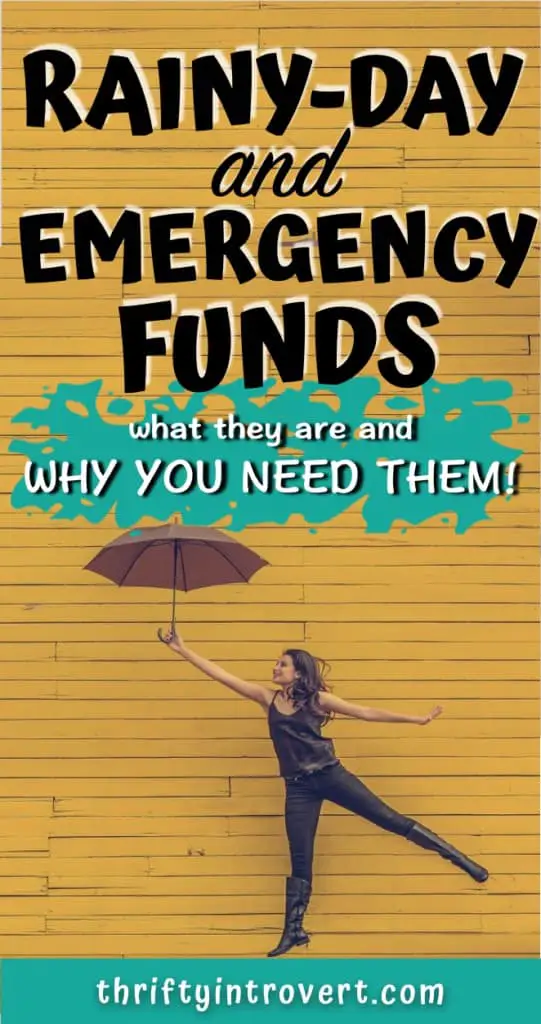Rainy Day Fund vs Emergency Fund – Why You Need BOTH!

This post may contain affiliate links. If you decide to purchase through my links, I may earn a small commission. Read my disclosure page for more info.
Rainy day fund, emergency fund—they’re all the same, right?
In a word…no.
Although we often use these terms interchangeably, rainy day funds and emergency funds are two completely different things.
Don’t worry. I didn’t know the difference before either!
On our paths to financial freedom, it’s important to understand what both of these funds are, what they’re used for, and how to start saving for them.
So let’s discover the differences between a rainy day fund vs emergency fund, and why they’re both necessary to achieve financial security and freedom!
Rainy Day Fund vs Emergency Fund
What is a rainy day fund?
Basically, a rainy day fund is savings that you keep liquid (easily accessible) for those one-off purchases that pop up throughout the year.
Think:
- a new set of tires on your car
- a vet bill
- a shattered iPhone screen (We’ve all been there!)
- a doctor’s office bill
- a laundry machine that stops working
- a computer that needs repair
You get the point. Basically, a rainy day fund is for those wonderful moments when life happens (…ugh).
A rainy day fund is a smaller amount of savings than an emergency fund—aim for $1000-$3000 to cover these smaller, unexpected expenses that are outside of your monthly budget.
What is an emergency fund?
An emergency fund is savings you set aside for just that: emergencies.
What constitutes an “emergency”?
Well, you may be thinking that a shattered iPhone screen is an emergency—the pain is real; I get it!
However, we’re talking ACTUAL, worst-case scenario emergencies like:
- losing a job
- quitting a job
- being injured and unable to work
A good rule of thumb is that your emergency fund should have enough to cover 3-6 months of expenses. Your emergency fund floats you for a few months, so you’re still able to pay for your fixed monthly expenses (rent, utilities, car payment, insurance, etc.) as well as other necessary monthly expenses, like groceries and gas.
For example, your fixed monthly expenses are $1800 and you spend about $400 on groceries and gas every month, for a total of $2200 per month. Therefore, your emergency fund should contain anywhere between $6,600-$13,200 (3-6 months).

Why do I need a rainy-day fund?
Now that you know the difference between a rainy day fund vs an emergency fund, it’s important to note that you actually need both—not just one of them!
The primary reason why you need a rainy day fund is to stay on budget and not go into debt.
If you’re not sure how to create a budget, take a look at my 11 Simple Steps to Creating a Budget!
It’s tempting to just put those larger, one-off purchases on our (high-interest) credit cards and say to ourselves, “Yeah, I’ll pay it off next paycheck, no problem”.
But…then there is a problem, and the credit card balance sits there from one month to the next accruing interest (read: losing money!).
By doing this, you risk going further into debt because suddenly, that purchase and the compound interest added to it, just snowballs into an amount that’s entirely unmanageable.
Related Read: 13 Mistakes You’re Making That Are Keeping You in DEBT
Why do I need an emergency fund?
That $1000-$3000 rainy day fund might help you stay out of debt for most hiccups in life, but it isn’t going to be enough to cover all of your monthly expenses if you lose your job, for example.
Your emergency fund keeps you out of debt during an emergency, which typically lasts over an extended period of time. It gives you that much-needed safety net and financial security, reassuring you that you’ll still be okay if (hopefully not when!) the worst happens.
A rainy day fund and an emergency fund are BOTH necessary in order to be financially stable and therefore worry-free!
Where should I keep my rainy day fund and emergency fund?
Earlier I said that your rainy day fund should be liquid or easy to access. Therefore, you should keep your rainy day fund in cash (but NOT in your wallet) or a savings account.
Don’t keep your rainy day fund in your checking account because you’ll be tempted to spend it! It’s best to keep your rainy day fund somewhere you can get to it but not too easily.
Your emergency fund should also be kept somewhere you can easily access as well. However, because your emergency fund is a significantly larger amount of money, you should put this in a high-yield savings account and earn interest on it!
A normal savings account earns an interest rate of less than 0.1% annual percentage yield (APY). That’ll earn you pennies, guys.
However, if you put your emergency fund in a high-yield savings account, you’re looking at earnings of 1.70%-1.90% APY! That’s a significant difference, when we’re talking about an account with $10,000+ dollars.
I also recommend placing your emergency fund in a high-yield savings account not with the same bank you use for your checking account. When your checking account is linked to a savings account, you’re more likely to withdraw from your savings. Instead, your emergency fund will sit in a completely separate bank and account, and reap the benefits of that high APY!
How do I start saving for both?
I know. You’re doing the math in your head and feeling completely defeated, and you haven’t even started saving yet.
Saving money doesn’t mean you have to give up your hobbies, sell your car and walk 5 miles to work, or even worse: cancel your Netflix subscription. Nooooo!
The trick to saving money is to create a budget, track your spending, then find small, frugal ways to cut expenses on everyday items.
This takes time; there’s no way around that fact. But you have to create a financial plan before you can start working towards it.
Don’t just give up Starbucks forever and think that’ll do the trick. Enjoy the things you love, but find things that bring you less joy and spend more frugally on those. (Psst, there are even tricks to get free Starbucks drinks you can use!)
Here are other creative ways you can boost your savings (or income!) and start to build your rainy day and emergency funds:
- Do a no-spend challenge for a day, week, even month!
- Turn a hobby you love into a side-hustle and put the extra cash towards your funds.
- Make meal-planning a routine and only buy the groceries that you need for each week.
- Sell your used items and clothing from around the house.
- Cut down your energy and utilities use by turning off electronics, lights, water, and A/C.
- Find easy budget meal ideas for work lunches and pack your lunch instead!
- Start using apps and browsers like Rakuten and Ibotta to earn cash back for doing your normal shopping! Don’t change your spending habits and make money at the same time.
- Rakuten —Rakuten offers cash back and discounts at some of your favorite online retailers. If you’re looking to purchase something, do it through Rakuten and you can start getting discounts AND making money off purchases. Get a $10 BONUS today!
- Ibotta — Whether you’re shopping online or in-store, Ibotta has you covered. Link your loyalty cards from your favorite stores and within 24 hours, you’ll get cash back on your purchases! Get a $20 WELCOME BONUS for signing up!
- Take online surveys to earn extra cash. Here are the top 3 online survey companies that I recommend:
- Swagbucks — All you do is take online surveys, watch videos or movie trailers, and earn points. Then, redeem those points for gift cards to places like Amazon and Walmart, or Paypal money! It’s simple and you can sign-up today and start getting rewards.
- Survey Junkie — Survey Junkie works with a few different companies to do market research. It’s simple: you take surveys, and get cash. So while you’re sitting on the subway or pausing between episodes of a TV show, you can start getting paid.
- Inbox Dollars — They offer a variety of ways that you can start earning cash back. You can take surveys, watch videos, play games, simply shop online, and more! There are so many ways to start earning cash, it’s unbelievable.
Related Read: 21 Extreme Frugality Tips To Save $1000s!
Final Thoughts
So there you have it: the difference between a rainy day fund vs emergency fund.
And I get it:
When we think about saving around $10,000+ dollars for both of these funds, it seems like an impossible task.
But I’m here to tell you it isn’t, and you CAN save that and more!
The trick is to create a simple, easy to follow budget that actually makes tracking your finances—FUN.
Yes, budgeting requires you to make difficult, strategic decisions about your money.
But by setting goals, making a plan, and executing it, you’ll discover how budgeting can positively transform your relationship to money.
You’ll no longer stress about money, because you’ll have a financial plan.
You’ll achieve your money goals, because your strategy will become second-nature.
So to get started, check out my 11 Simple Steps to Create a Fail-proof Budget!
Also, download and save my 75 EASY frugal hacks to your phone, so that you can start building your rainy day and emergency funds today!
For more ways to save money, check out these articles:
- 75 Easy Frugal Living Tips to Save Money Now!
- Amazon Direct Ship Ultimate Guide: Get FREE Stuff Delivered to You
- 11 Simple Steps to Create a Budget THAT WORKS!
- How to Do a No-Spend Challenge and CRUSH Your Money Goals
- How to Save Money on Hobbies (Without Giving Them Up)
- Gross Pay vs Net Pay: How to BUDGET the Right Way
